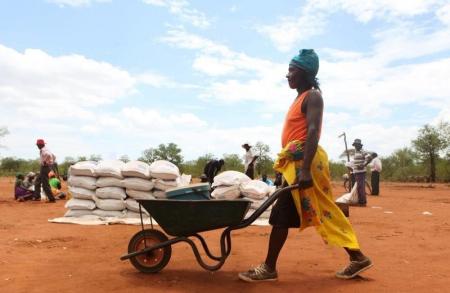
OVER 4 million Zimbabweans are facing starvation while the number of food-insecure is set to rise to 8,6 million, about 60% of the population by year-end due to the combined effects of drought, economic recession and the COVID-19 pandemic.
BY RICHARD MUPONDE
Currently, 4,3 million Zimbabweans are vulnerable and rely on food handouts.
The World Food Programme (WFP), which is at the forefront in providing humanitarian assistance is facing a funding gap of US$180 million for Zimbabwe’s aid assistance programme.
WFP Zimbabwe representative and country director Francesca Erdelmann, speaking to Xinhua on Wednesday, said 2020 had been a tough year for the donor community.
WFP projections indicate that by year-end, the number of food-insecure Zimbabweans would have surged by almost 50% to 8,6 million or 60% of the population owing to the combined effects of drought, economic recession and the COVID-19 pandemic.
“For our portfolio in Zimbabwe, between now and the next six months, we are short by about 180 million United States dollars,” Erdelmann said.
“These are not amounts of money that are easy to mobilise and for most of our donors; it’s tough for them too.
- Chamisa under fire over US$120K donation
- Mavhunga puts DeMbare into Chibuku quarterfinals
- Pension funds bet on Cabora Bassa oilfields
- Councils defy govt fire tender directive
Keep Reading
“So we really have to try and make sure that we can reach our targets and deliver the support to the people but if we can’t, we are going to have to make some tough choices and target only the most vulnerable groups.”
In September, the WFP started cash disbursements for the urban social assistance programme after getting funding from the US through the United States Agency for International Development (USAid).
USAid’s support was meant to benefit vulnerable families in eight urban areas across Zimbabwe struggling to meet their food needs due to COVID-19.
USAid and WFP are catering the needs of people living in Gokwe, Redcliff, Kwekwe, Ruwa, Chinhoyi, Buhera, Chipinge and Chegutu.
The financial assistance from USAid allows WFP to provide support to over 103 700 people with monthly cash-based assistance equivalent to US$12 each, enabling them to meet almost two-thirds of their daily food requirements up to January. The USAid and WFP programme is meant to reach the most vulnerable and food insecure families, particularly women, people who are unemployed, and people suffering from chronic illnesses or disability.
Zimbabwe’s food security dilemma comes at a time the UN has published the Global Humanitarian Overview 2021 which warned that up to 235 million people globally will need humanitarian assistance next year, a 40% increase on the number at the start of 2020.
A humanitarian organisation, Concern Worldwide, is already calling for an urgent international response to meet the needs of millions of people and avert multiple humanitarian crises including famine in 2021.
The UN estimates that the global humanitarian response for 2021 will cost $35 billion. This cost must be fully funded by the international community.
“We know first-hand the difference that early intervention can make,” said Kirk Prichard, Concern vice-president for programmes.
“We can prevent communities on the verge from slipping into starvation and destitution.”
Global Humanitarian Overview 2021 noted that COVID-19 had had a hugely damaging impact and reversed broader development gains, with extreme poverty now rising for the first time since 1998.
“The wealthiest nations have been cushioned by extraordinary surges of credit unleashed by central banks, and government spending, collectively estimated at more than $8 trillion. Developing countries are yet to receive help on such a scale,” part of the findings read.











